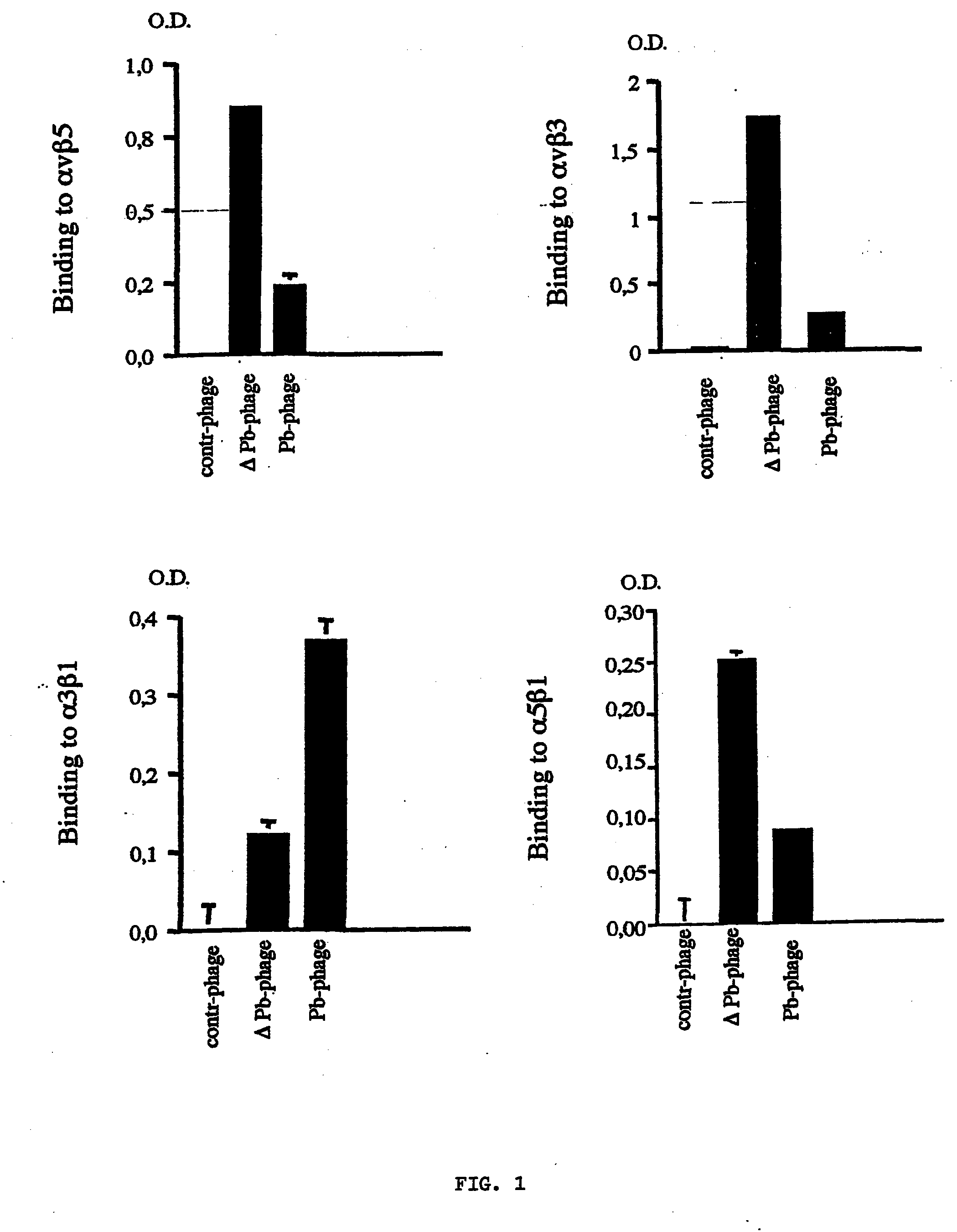Chimeric vectors and their use for heterologous genes transfer
a technology of heterologous genes and chimeric vectors, applied in the field of chimeric vectors and their use for heterologous genes transfer, can solve the problems of reducing the infectivity and the effectiveness of gene transfer vectors, requiring a large amount of preparation and purification, and eukaryotic virus engineering is also highly complex
- Summary
- Abstract
- Description
- Claims
- Application Information
AI Technical Summary
Problems solved by technology
Method used
Image
Examples
example 2
In-Vitro Bond of the Chimeric Phages to the Integrins
[0077] In order to verify whether the phage structure allows the functional expression of the integral and deleted penton-base protein and whether the latter keeps the binding properties to integrins which are typical of the integral protein, the binding of the chimeric phages to purified integrins .alpha.v.beta.3, .alpha.v.beta.5, .alpha.5.beta.1 and .alpha.3.beta.1 (Chemicon, Temecula Calif.) was measured in vitro. 96-well plates were coated with the purified proteins for 16 hours at 4.degree. C., then washed and blocked in TBSMT added with Ca.sup.++ (TBSMT+). The chimeric phages were added to the wells and incubated for 2 hours. In competition tests, said coated wells were pre-incubated 1 hour before the addition of the phages with GRGDSP or GRGESP peptides (Sigma, St. Louis, Mo.). The phages bound to the plate were detected with an anti-M13 monoclonal antibody for pVIII protein (Amersham-Pharmacia Biotech), diluted 1:500 in TB...
example 3
In-Vivo Internalization of Chimeric Phages
[0081] The capacity of the phage to bind and to be internalized in vivo was verified by electron microscopy (a) and immunofluorescence (b) on HeLa was cells. The quantification of binding and internalization levels of the chimeric phages was carried out by micropanning on HeLa, CS-1 and CS-1 / .beta.3 cells (c).
[0082] Cell Cultures
[0083] Hela cells (ATCC no. CCL-2) are grown in DMEM / 10% fetal calf serum (FCS). CS-1 and CS-1 / .beta.3 are grown in RPMI / 10.degree. / , for the second group of cells with the addition of G418 (Genetycin, Sigma, St. Louis, Mo.) 500 .mu.g / ml.
[0084] a) Electronic Microscopy
[0085] 10.sup.5 HeLa cells were plated 48 hours before and incubated with 3.times.10.sup.12 .DELTA.Pb phages and 9.times.10.sup.12 Pb phages, respectively, and incubated for 1 hour at 4.degree. C. After being washed the cells were fixed for 10' in 2% glutaraldehyde in 0.15 M Hepes buffer at pH 7.3 and fixed for electronic microscopy for 1 hour at 24.deg...
example 4
Evaluation of Transduction Efficiency of Eukaryotic Cells (HeLa, CS-1 and CS-1 / .beta.3) with Chimeric Phages by Expression of GFP Reporter Gene
[0097] The expression of GFP reporter gene (Green Fluorescent Protein) was carried out by FACS analysis as follows: 1.times.10.sup.5 cells (HeLa, Cs-1 / .beta.3 or Cs-1) were plated in 6-portion wells. After 24 hours the cells were incubated for 1 hour at 4.degree. C. and for 3 hours at 37.degree. C. with 2.times.10.sup.13 chimeric particles (Pb-GFP and .DELTA.Pb-GFP phage) containing the gene for GFP. After the washings and 72 hours of incubation in fresh medium the expression levels of GFP protein were measured by FACS. The specificity of the measured signal was evaluated also in presence of GRGDSP or GRGESP peptides, pre-incubating the cells for 1 hour, with peptide concentration of 4.86 .mu.M, corresponding to a molar excess of about 2000 times and maintaining said concentrations in the following incubations. 10.sup.4 cells were measured fo...
PUM
| Property | Measurement | Unit |
|---|---|---|
| temperature | aaaaa | aaaaa |
| temperature | aaaaa | aaaaa |
| temperature | aaaaa | aaaaa |
Abstract
Description
Claims
Application Information
 Login to View More
Login to View More - R&D
- Intellectual Property
- Life Sciences
- Materials
- Tech Scout
- Unparalleled Data Quality
- Higher Quality Content
- 60% Fewer Hallucinations
Browse by: Latest US Patents, China's latest patents, Technical Efficacy Thesaurus, Application Domain, Technology Topic, Popular Technical Reports.
© 2025 PatSnap. All rights reserved.Legal|Privacy policy|Modern Slavery Act Transparency Statement|Sitemap|About US| Contact US: help@patsnap.com



